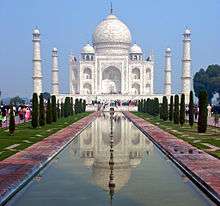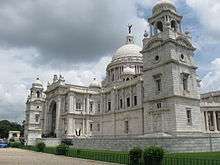Makrana marble

Makrana marble is a type of white marble of high quality, popular for use in sculpture and building decor. It is mined in the town of Makrana in Rajasthan, India, and was used in the construction of several iconic monuments such as the Taj Mahal in Agra and the Victoria Memorial in Kolkata.
Geology
In the Makrana area, marble is found as five steeply-dipping bands.[1] They form part of the Ajmer Formation of the Delhi Supergroup, which is a sequence of sedimentary rocks that was deposited in the Delhi Basin during the Proterozoic. About 1450 Ma (million years ago) these rocks were affected by the Delhi Orogeny, causing the metamorphism that transformed the original limestones to marble and the folding that caused the steep dip and the current outcrop pattern.[2]
Properties
Makrana is regarded as the oldest place in India with a marble quarry. Upon mining, Makrana marble is not subjected to any form of treatment, but used in cutting and chiseling straight away.[3] Makrana marble is one of the two calcitic marble varieties in India, with all others being dolomitic.[4] It has two varieties: white and albeta.[1] The quantity of marble reserves in the region is estimated to be 55 million tonnes by the state government.[4] About 120 thousand tonnes of the marble are produced annually from over 400 mines in the region.[5]
Makrana marble has high percentage of calcium and is therefore resistant to water seepage.[1] The water absorption of Makrana marble is said to be the lowest among all types in India, and the marble is claimed to contain 98 percent of calcium carbonate and only two percent of impurities. The different shades of Makrana marble are pure white, white with grey shades and white with pink shades, depending on the level of impurities. The close interlocking property of the marble makes it strong, hard and translucent. It is said to retain its shine and white color for a long period of time.[4]
Types of Makrana Marble
Makrana Marbles splits into various categories according to its design and pattern. The following are the exclusive marbles which are mined and manufactured at Makrana.
Makrana White Marble- Makrana marble is highly used in residential & commercial buildings and numerous temples, mosques, churches, and monuments, it can be used for decorative purpose in houses, hotels, corporate offices and Restaurants, western and Indian sculptures, handicrafts.
Brown Albeta Marble- This marble stone is a calcite stone. It is a milky white marble and also available in grey and panther brown pattern. The stone is available in various forms such as natural blocks, large & small slabs, regular tiles.
Dungri Marble- Dungri Marble is one of the oldest and fine quality marble of makrana based mines. This stone is widely used in flooring, and wall cladding due to its some special quality like no chemical reinforcement, no color changes, and no pin holes.
Albeta Marble- Albeta Marble is one of the best as well as highly recommended stone for floor designs which gives luxury look to the home. The color of albeta makrana marble is milky white with brown texture.[6]
Notable monuments and buildings

Prominent buildings/monuments that used Makrana marble in their construction are:
- Taj Mahal, Agra, India[7][8][9]
- Victoria Memorial, Kolkata, India[7] – Makrana marble was chosen over various other European types in the construction of the Victoria Memorial, after several tests concluded Makrana marble to be superior. Sir Thomas Henry Holland, a British geologist, was given credit for recommending the use of Makrana marble in the construction of Victoria Memorial.[10]
- Sheikh Zayed Mosque, Abu Dhabi, UAE[11][12]
- Moti Masjid, Lahore, Pakistan[13][14]
- Dukhnivaran Sahib Gurdwara, Ludhiana, India[15]
Use and export
Marble from Makrana is exported overseas mainly to the Persian Gulf countries, the European Union, Southeast Asia, Canada, Pakistan and Russia.[4][5] In India, it is mainly used for handicraft and sculpture work, apart from construction of buildings.[4] Makrana marble was given the geographical indication status in 2015 by the Geographical Indication Registry, Chennai.[16]
References
- 1 2 3 "Makrana Marble" (pdf). portal.gsi.gov.in. Retrieved 31 January 2016.
- ↑ Roy, A. & Purohit R. "4. Lithostratigraphic, geochronological and depositional framework of the Precambrian basins of the Aravalli Mountains and adjoining areas, Rajasthan, India". In Mazumder R. & Eriksson P.G. Precambrian Basins of India: Stratigraphic and Tectonic Context (PDF). Memoirs of the Geological Society. 45. Geological Society, London. pp. 55–65. doi:10.1144/M43.4.
- ↑ Govind, Ranjani (4 February 2012). "There is magic in the Makrana marble". The Hindu. Retrieved 31 January 2016.
- 1 2 3 4 5 "G.I. Application Number – 405" (PDF). Government of India Geographical Indications Journal. 64: 7–14. 2014. Archived from the original (PDF) on 2015-04-19.
- 1 2 Siva, Meera (26 July 2015). "Tiles can floor marble". The Hindu Business Line. Retrieved 31 January 2016.
- ↑ Mahaveer Marble Pvt Ltd Types of Makrana Marble
- 1 2 "Kolkata's landmark Victoria Memorial getting makeover". The Times of India. 22 July 2015. Retrieved 4 February 2016.
- ↑ McFarland, Rob (13 August 2015). "A rare glimpse behind India's tourist facade". stuff.co.nz. Retrieved 4 February 2016.
- ↑ Rysman, Laura (22 November 2015). "The Boucheron Collection That Came Out of India". The New York Times. Retrieved 4 February 2016.
- ↑ "Superiority of Makrana (Rajasthan) Marbles" (pdf). insa.nic.in. Retrieved 31 January 2016.
- ↑ Shikhani, Ammar (24 November 2010). "UAE: Queen Elizabeth Visits Sheikh Zayed Grand Mosque". Global Arab Network. Retrieved 4 February 2016.
- ↑ "ये है दुनिया की सबसे खूबसूरत मस्जिद, अंदर लगा है मकराना का मार्बल". dainikbhaskar.com. 17 August 2015. Retrieved 4 February 2016.
- ↑ Dar, Nadeem (20 June 2015). "A pearl inside Lahore Fort – Moti Masjid". Pakistan Today. Retrieved 4 February 2016.
- ↑ Shahid, Mahnoor (3 January 2015). "Historical mosques of Lahore". Pakistan Today. Retrieved 4 February 2016.
- ↑ Goyal, Divya (14 September 2015). "Dukhnivaran Sahib Gurdwara: Prayer hall thrown open to public, after 15 years of renovation". The Indian Express. Retrieved 4 February 2016.
- ↑ "India's GI List Gets Longer with 20 New Products". The New Indian Express. 6 April 2015. Retrieved 31 January 2016.